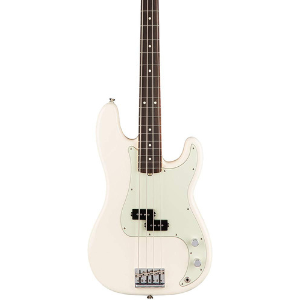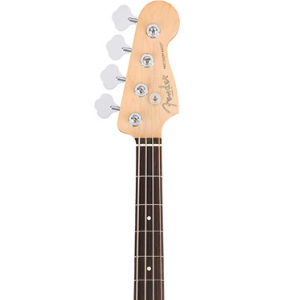- Home
- Instruments
- Gear
- Recording
- Lessons
- Reviews
- Blog


| Body And Neck: |  |
| Electronics: |  |
| Hardware: |  |
| Sound: |  |
| Value: |  |
Out of all of Leo Fender's pioneering designs, the Precision Bass might be the most innovative. As the first electric fretted bass ever produced, it's paved the way for generations of legendary players in all different styles of music. Along the way, the P Bass has become renowned for its quintessential low-end tones and unbelievable versatility.
In the modern era, Fender recently reorganized their product lineup to bring their classic designs back onto the cutting edge. The American Professional Precision Bass, one of the company's top-end American production models, boasts a combination of vintage and modern features that are designed to impress even the most discerning bassists.
Manufactured in Corona, California, this model is definitely one of the best bass guitars you'll find in production. Let's take a closer look at the details to break down why.
 Body and Neck
Body and NeckThe body on the American Professional Precision Bass uses alder, a classic Fender tonewood known for its clear and flexible tonal profile. The iconic double-cutaway shape and body contours keep the instrument lightweight, while the twin horns preserve the balance between the body and neck.
Speaking of the neck, this edition is a maple neck shaped after a 1963 P Bass profile. It's a standard C shape that's comfortable and smooth, though it still provides a solid foundation for players to grab a hold of. Depending on the finish of the body, you can get this instrument with either a maple or a rosewood fingerboard. Maple offers a brighter, ringing top-end while rosewood is often regarded as warmer through the bass and midrange.
A pair of Posiflex graphite rods flank the truss rod in the neck. They help counteract the tension from the heavier bass strings and keep your neck perfectly aligned without the need for adjustments. While you might not notice the difference if you play around the house, the graphite rods come in handy if you expose your instrument to lots of different temperatures and environments — they make gigging, road-tripping, and flying with your bass much less of a hassle.

The P Bass's calling card has always been its sleek yet flexible electronics setup. While there's only one pickup, this bass offers more compelling tones than many competing models with two pickups. For the American Professional series, Fender has created a special V-Mod pickup for an even wider range of different sounds.
The bass side of the pickup uses an Alnico II magnet for a rounder, more open low-end; the treble side uses an Alnico V magnet for extra clarity and articulation. Outside of the pickup itself, this Precision Bass also includes a pair of chrome knobs to control your volume and tone.
The American Professional stands out from other P Basses in the Fender lineup thanks in part to its hardware. Though the modifications to this model are relatively simple, they combine to make a significant difference in the feel and sound of the instrument.
One of the most noticeable differences is the new “narrow tall” fret wire. A feature first designed for the guitars in the American Professional series, it's been carried over to the Precision Bass as well.
The more pronounced, thin shape encourages precise bending and chording. Though those qualities aren't as helpful for bassists as they are guitarists, the narrow tall frets come in handy for one crucial component: vibrato. The extra-tall wire lessens the contact between the string and fretboard for a smoother, more fluid vibrato that's easy to create.
Fender has also made some upgrades to the scale itself. Compared to the standard vintage bridge, the HiMass version on this model resonates better and slightly increases sustain. In a unique touch, you can also choose to string this bass through the body or top-load it.
At the other end of the neck (past the genuine bone nut), you'll find fluted tuners. Many players find these are easier to string than standard models, and they can increase the downward break of each string to boot.
In some ways, it can be difficult to judge the sound of any Precision Bass — the model is so ubiquitous that it can sound familiar and even generic at times. The American Professional version maintains the same balanced range and fat low-end warmth that the P Bass is known for.
However, the American Pro distinguishes itself with its extra-sleek sound. Notes on this instrument feature plenty of clarity, yet they stay glassy and smooth. Picking and slapping the bass brings out some pop and sizzle if you want a more staccato sound.
While it might not be as in-your-face as some other bass models, the P Bass has its own character. It's also far easier to incorporate into a mix than bass guitars optimized for lead playing. Simply put, the P Bass offers the quintessential bass sound. It's a difficult package to beat.
The Fender P Bass is one of the most iconic fretted instruments ever made. It's difficult to improve on a model that carries such a storied history — but the American Professional P Bass offers a few thoughtful upgrades to the famous design. If you're looking for a premium bass that combines great vintage and modern components with top-notch build quality and style, this P Bass model is a good fit for you.
For more info about the Fender American Professional Precision Bass, click here.

Reader Interactions